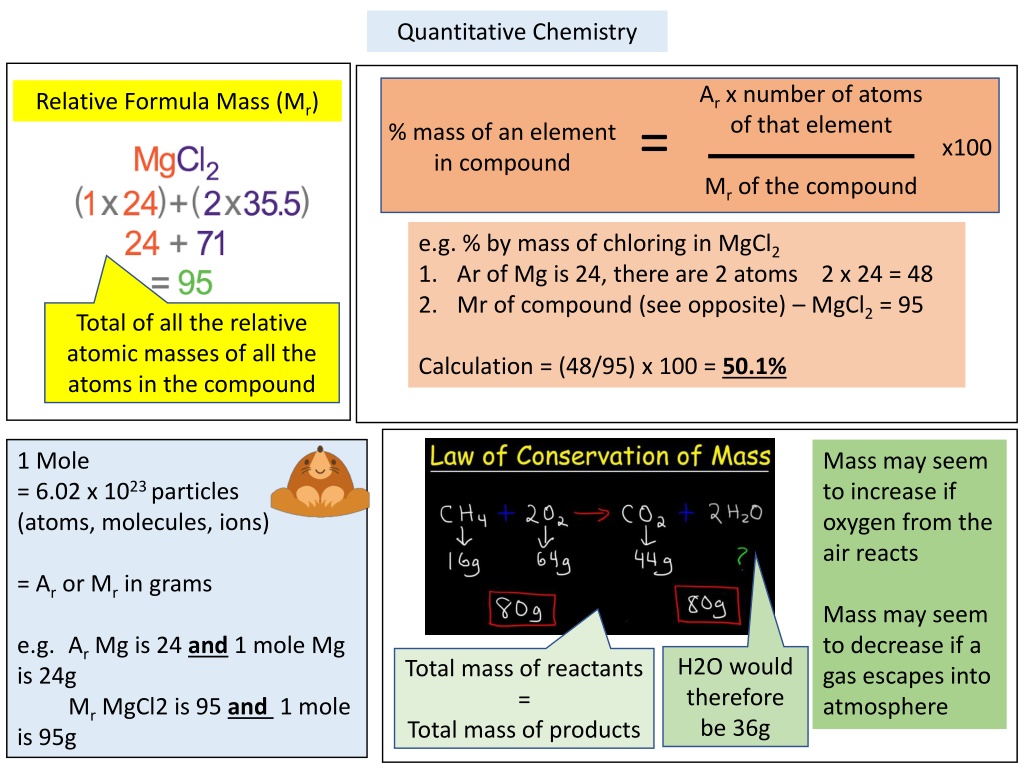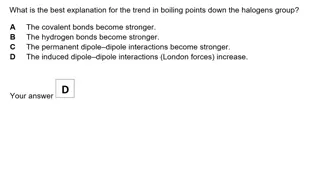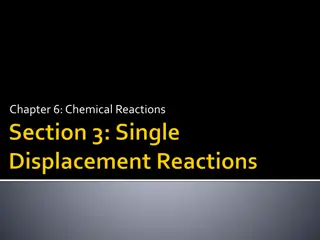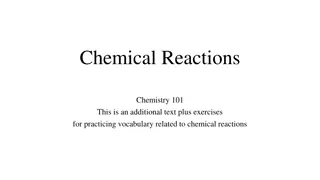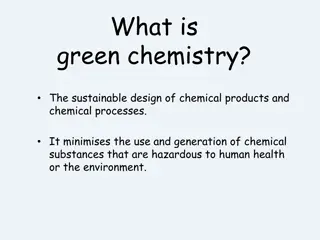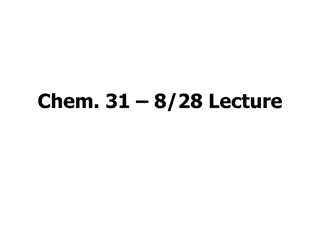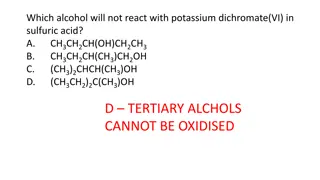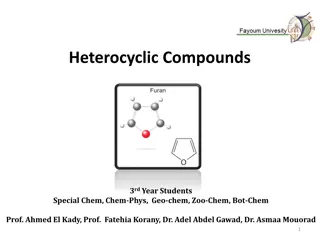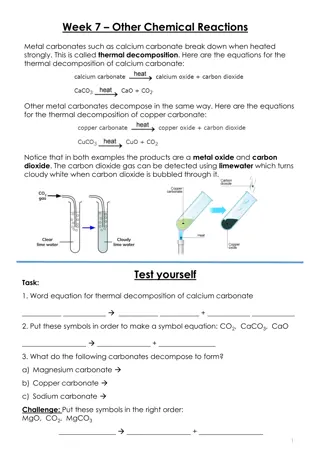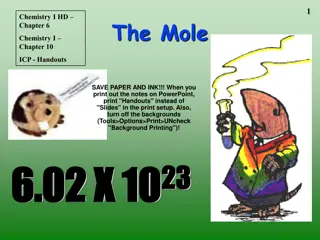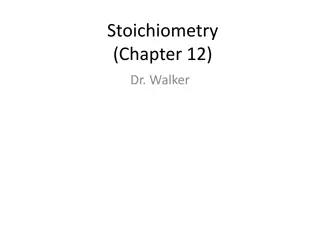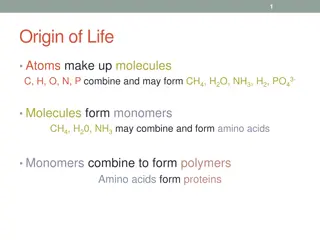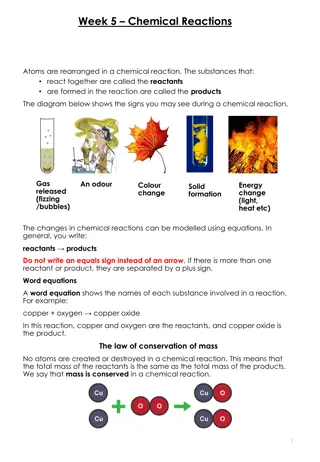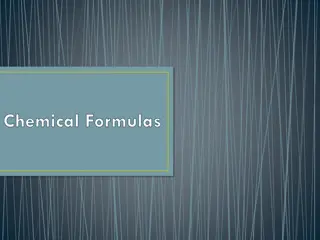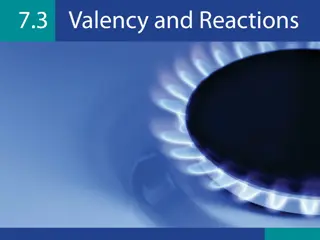Understanding Quantitative Chemistry in Chemical Reactions
Explore the fundamentals of quantitative chemistry, from calculating percentages by mass to determining limiting reactants. Learn how to work out balanced symbol equations and solve concentration questions with ease. Enhance your knowledge of moles, molecular masses, and more in chemical reactions.
Download Presentation

Please find below an Image/Link to download the presentation.
The content on the website is provided AS IS for your information and personal use only. It may not be sold, licensed, or shared on other websites without obtaining consent from the author. Download presentation by click this link. If you encounter any issues during the download, it is possible that the publisher has removed the file from their server.
E N D
Presentation Transcript
Quantitative Chemistry Ar x number of atoms of that element Relative Formula Mass (Mr) = % mass of an element in compound x100 Mr of the compound e.g. % by mass of chloring in MgCl2 1. Ar of Mg is 24, there are 2 atoms 2 x 24 = 48 2. Mr of compound (see opposite) MgCl2 = 95 Total of all the relative atomic masses of all the atoms in the compound Calculation = (48/95) x 100 = 50.1% 1 Mole = 6.02 x 1023 particles (atoms, molecules, ions) Mass may seem to increase if oxygen from the air reacts = Ar or Mr in grams Mass may seem to decrease if a gas escapes into atmosphere e.g. Ar Mg is 24 and 1 mole Mg is 24g Mr MgCl2 is 95 and 1 mole is 95g H2O would therefore be 36g Total mass of reactants = Total mass of products
Working out the balanced symbol equations from the masses Learn and rearrange 1. Calculate number of moles by mass/Ar 2. Divide number of moles of each substance by the smallest number of moles 3. If any are not whole numbers multiply all by the same amount to become whole 4. Write the balanced equation 1. Calculate the number of moles in 34g of LiOH. (Li 7 O 16 H 1) Mr LiOH = (1 x7) + (1 x 16) + (1 x 1) = 7 + 16 + 1 = 24 8.1g ZnO reacts completely with 0.6g of carbon to form 2.2g of carbon dioxide and 6.5g zinc Number of moles = 34/24 = 1.4 mol 1. Mr ZnO = (65 +16) = 81 Mr C = 12 Mr CO2= 12 +(2 x 16) = 44 Mr Zn 65 2. Calculate the mass of water in 4.5mol (H 1, O 16) ZnO = 8.1 / 81 = 0.1mol C =0.6 / 12 = 0.05mol CO2 = 2.2 / 44 = 0.05 mol Zn = 6.5 / 65 = 0.1mol Mr water H2O = (2 x 1) + (1 x 16) = 18 2. Divide by the smallest 0.05 ZnO = 0.1/0.05 = 2 C = 0.05/0.05 = 1 CO2 = 0.05/0.05 = 1 Zn = 0.1 / 0.05 = 2 4.5 = mass / 18 4.5 x 18 = mass = 81g 3. Equation 2 ZnO + C CO2 + 2 Zn
Limiting Reactants In a reaction to produce sodium sulfide, Na2S, 9.2 g of sodium is reacted with 8.0 g of sulfur. Which reactant is in excess and which is limiting? Step 1: Write a balanced equation: 2Na + S Na2S (2 : 1 mols of Na react with S) Step 2: Calculate the relative formula masses (Mr): Na = 23, S=32 Na2S = (2 x 23) + 32 = 78 Step 3: Calculate the number of moles Na = 9.2/23 = 0.4 mols S = 8.0/32 = 0.25 mols but 1.6 : 1 mols of Na reacted with S Step 4: Identify the reactant in excess / limiting Na must be limited because there is less than 2mols (needs to be double of S but it is not S is in excess because it is more than half the number of moles of Na Look at p127 for an example to show how to calculate the mass of a reactant
Concentrations of solution 6 mark calculation questions Make sure you can do this! How many moles of NaOH are in a 25cm3 solution with a concentration of 56 g/dm3? Mass of solutes (g) Concentration (g/dm3) = Volume of solvent (dm3) Exam tip! Change volumes to dm3 1dm3 = 1000cm3 Step 1 and 2 use this equation 1. Change volume to dm3 25/1000 = 0.025dm3 2. Calculate mass 56 = mass / 0.025 56 x 0.025 = mass What mass of sodium chloride would be needed to form a 3.2g/dm3 in a 45cm3 solution = 1.4 1. Change volume to dm3 Step 3 and 4 use this equation Use the moles, mass and Mr equation 3. Calculate Mr NaOH = (1x23)+(1x16)+ (1x1) = 23 + 16 + 1 = 40 4. Number of moles = mass / Mr = 1.4 / 40 45/1000 = 0.045dm3 2. Calculate mass 3.2 = mass / 0.045 3.2 x 0.045 = mass = 0.144g Number of moles = 0.035 mols
